Compare the score distribution of 9 subjects
Deputy Minister of Education and Training Pham Ngoc Thuong affirmed that the 2025 High School Graduation Exam was a great success, ensuring the goals under the direction of the Party, the National Assembly, the Government and the Prime Minister. That is, considering and recognizing high school graduation, recording the results of 12 years of study of students. Evaluating the management and quality of general education, thereby serving as a basis for adjusting education policies, investing in facilities, and regimes for teachers and students. Providing reliable data for university admissions.
Changes in orientation, structure and question setting have been clearly shown through the score distribution of exam subjects, reflecting the level of differentiation and trends in educational innovation.
Mathematics: This is a challenging subject for average students. The 2025 score distribution has changed significantly: The average score has dropped from 6.45 to 4.78, the median from 6.8 to 4.6. The below average rate has skyrocketed to 56.4% (compared to 17.5% in 2024), but the number of candidates scoring 10 has increased sharply to 513. This shows that the exam has increased practicality and differentiation, but also poses an urgent need for sustainable math teaching, avoiding formality.

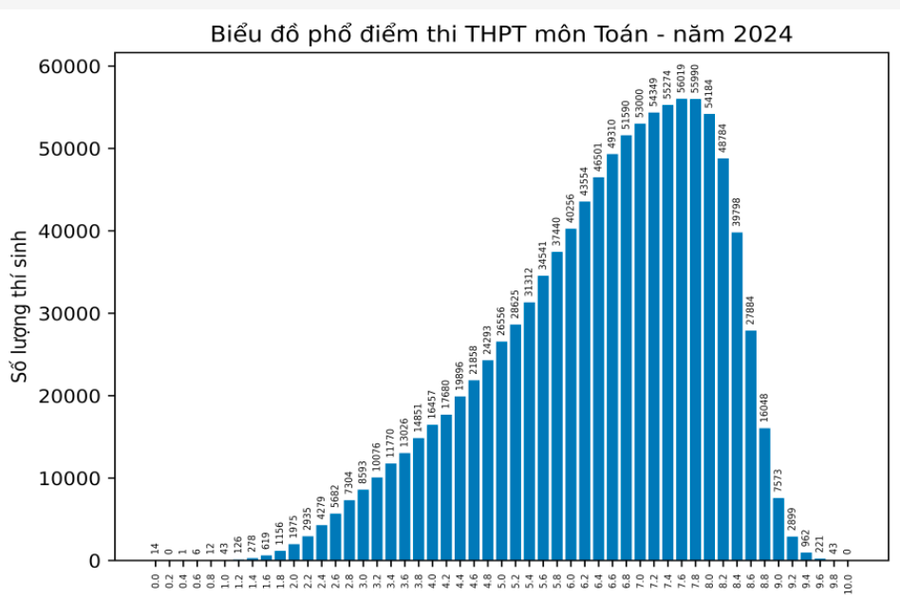
Literature: Maintain stability in innovation. Although the average score decreased slightly from 7.23 to 7.0 and the rate of achieving ≥7 points decreased to 59.6%, the score distribution remained stable. The test used materials outside the textbook, increasing the requirement for argumentation and thinking, helping to limit memorization of sample texts. Although there were no 10 points, many students achieved 9.75 points, showing that students were gradually adapting to the new assessment method.
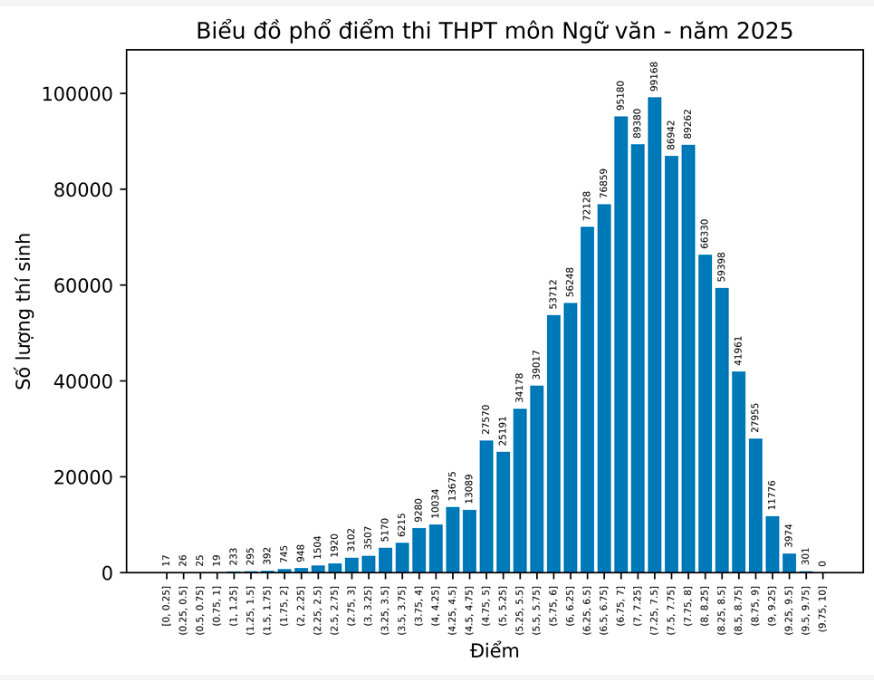
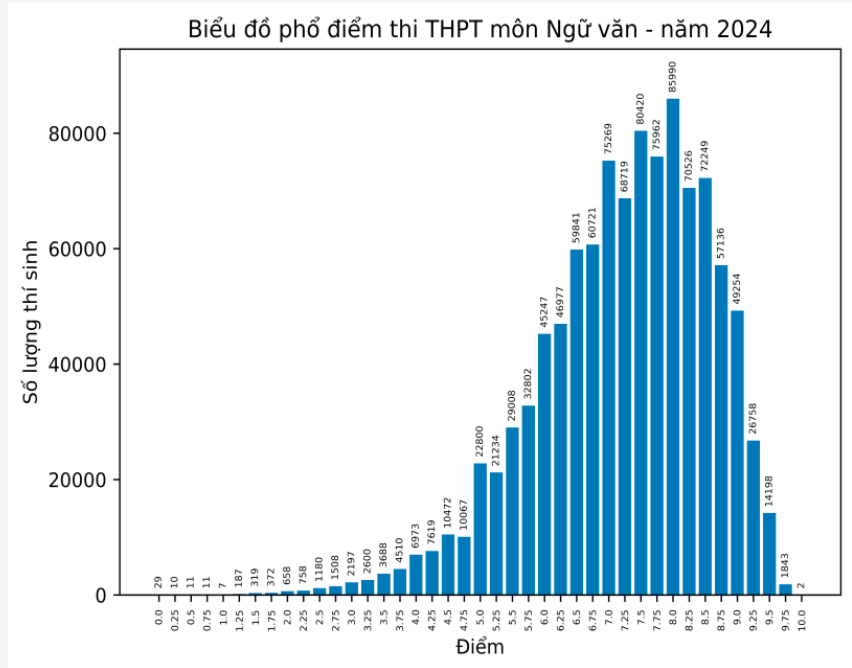
English: Although it is an elective subject, English still maintains its appeal with 30.19% of students registering for the exam. The average score decreased slightly from 5.51 to 5.38; the rate of ≥7 points decreased to 15.1%, while 38.2% were below average. The test was long, used a lot of real-life materials, closely assessed language proficiency, but also showed the need to improve foreign language teaching in high school. The English score distribution is standard, according to education experts, "very beautiful", no longer having 2 peaks like previous years.
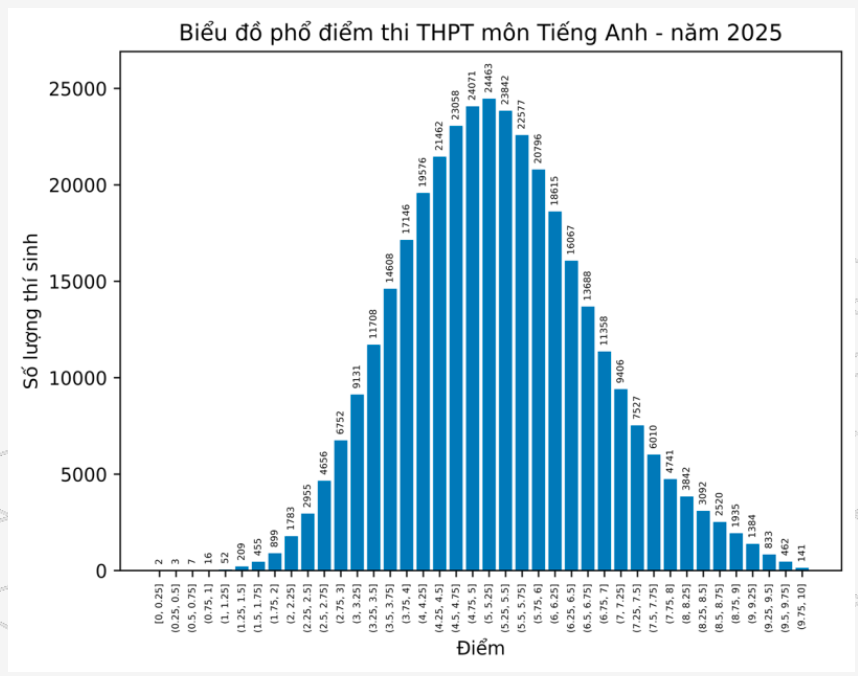
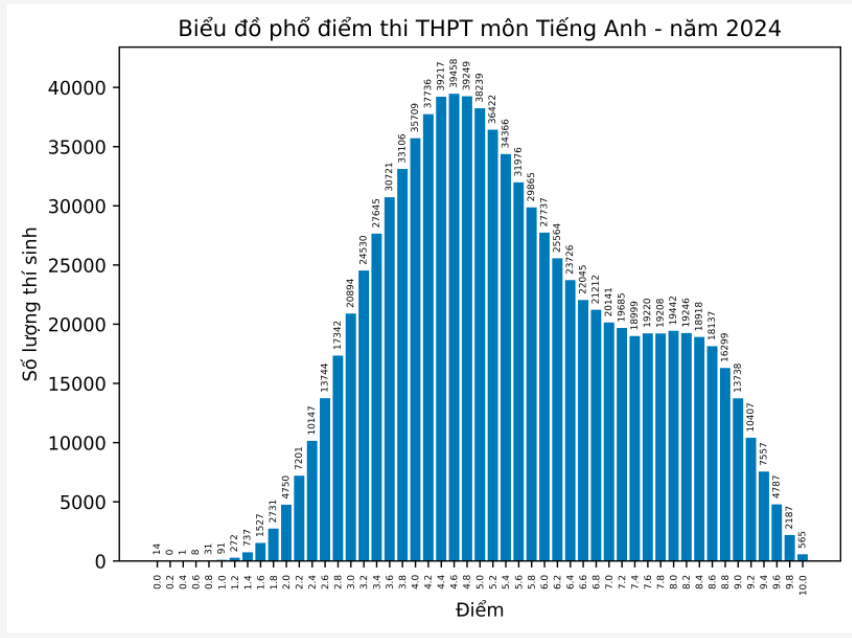
Physics: The quality has improved significantly. The average score increased from 6.67 to 6.99; the rate of scores below 5 points decreased to 9.8%. The number of candidates scoring 10 points increased sharply from 55 to 3,929. The exam developed the ability of good and excellent students and still maintained good classification, reflecting the effectiveness of the new teaching direction.
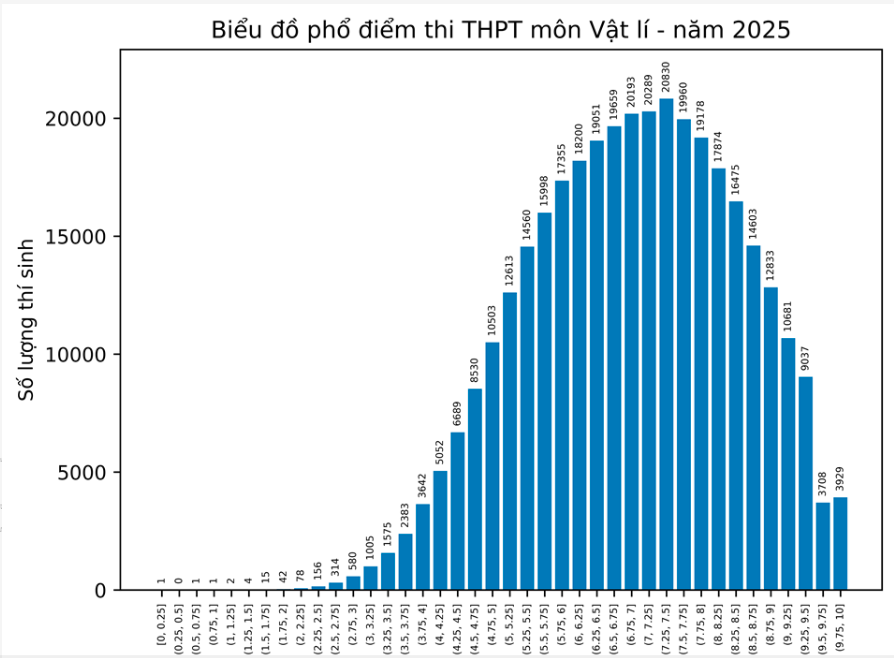
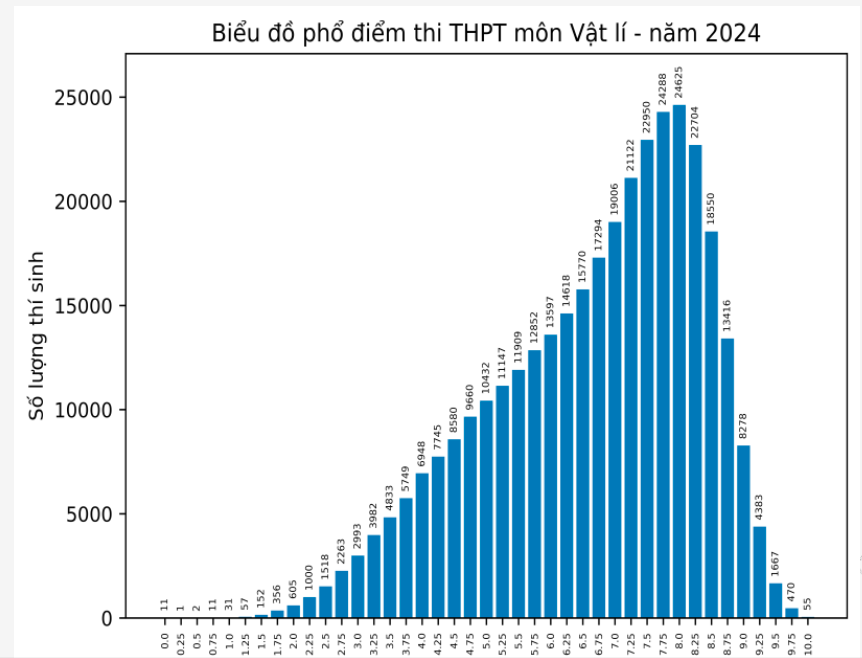
Chemistry: There are signs of decreasing attractiveness. The average score decreased from 6.68 to 6.06; the rate of achieving ≥7 points is only 33.7%, while nearly 30% scored below 5 points. The number of 10 points decreased by nearly half (from 1,287 to 625). The number of students choosing to take the exam decreased sharply, from more than 32% to 20.6%. This shows that it is necessary to innovate teaching methods to make Chemistry more familiar and attractive.
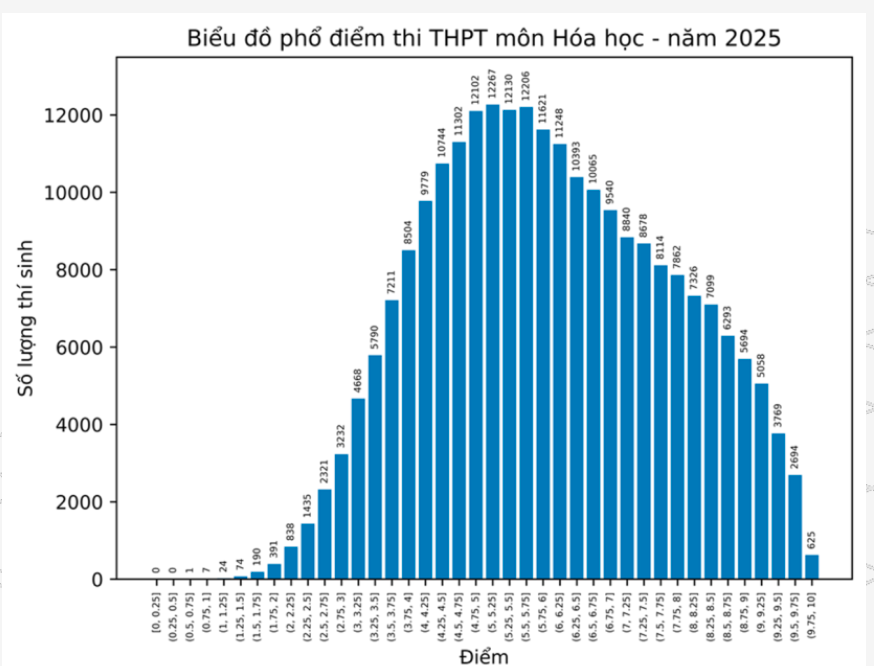
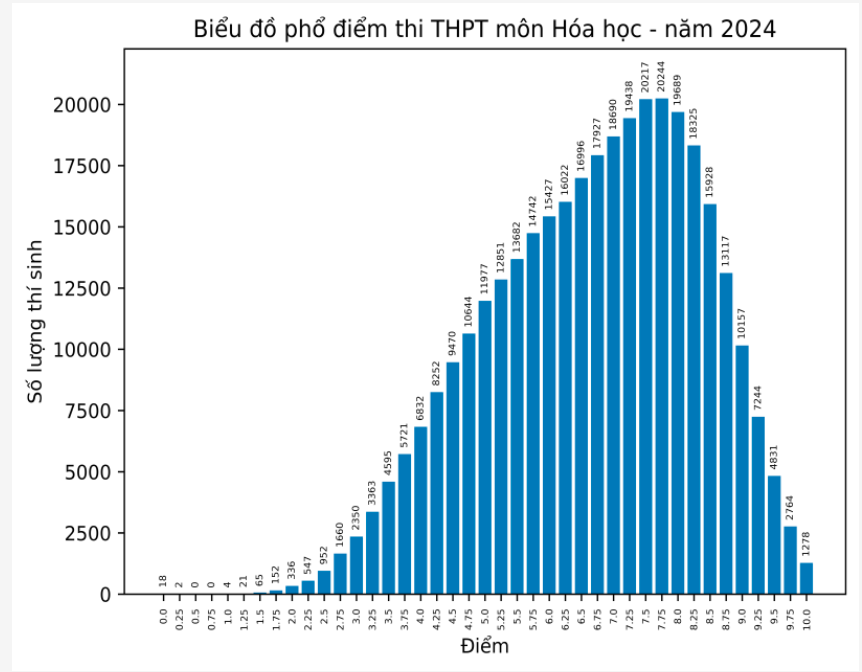
Biology: Imbalance between orientation and ability. Although only 6% of students chose to take the exam, the average score still dropped to 5.78; below 5 points accounted for 32.4%, and only 25.1% achieved ≥7 points. Although the number of 10 points increased slightly, the score distribution reflected the choice of subjects that were not suitable for ability - raising the need for increased career counseling and appropriate combinations.
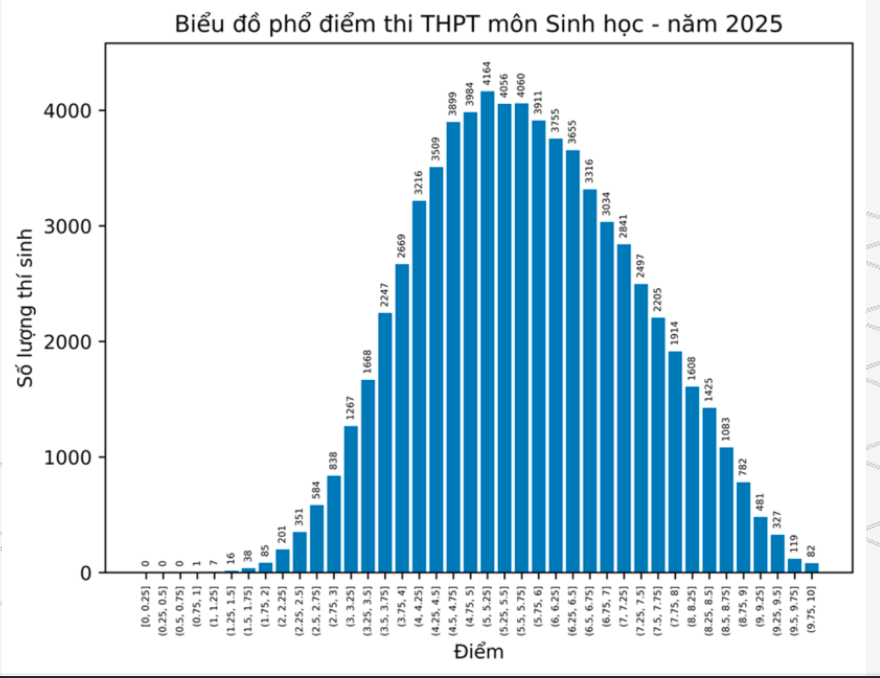
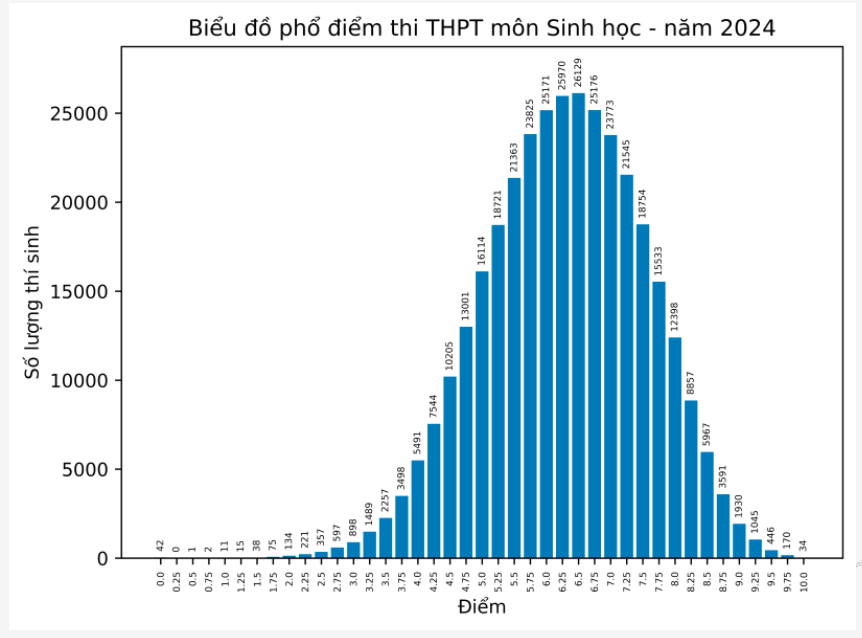
History: Still the most attractive elective subject (41.3%). Stable score distribution: Average score remains at 6.52, the rate of ≥7 points decreased to 25.15%. Although the number of 10 points decreased, the rate per 1,000 candidates increased slightly. The exam differentiated more clearly, affirming the position of History in the group of social subjects.
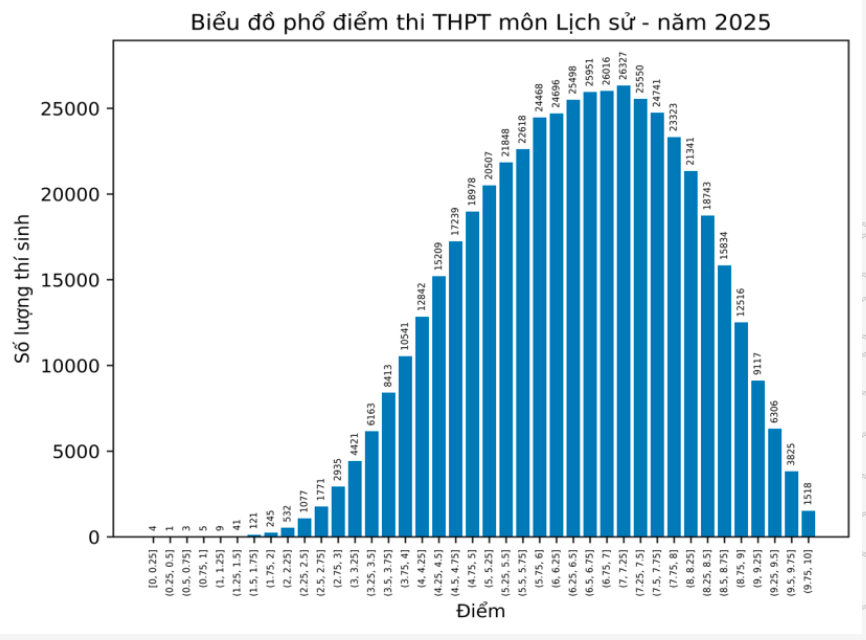
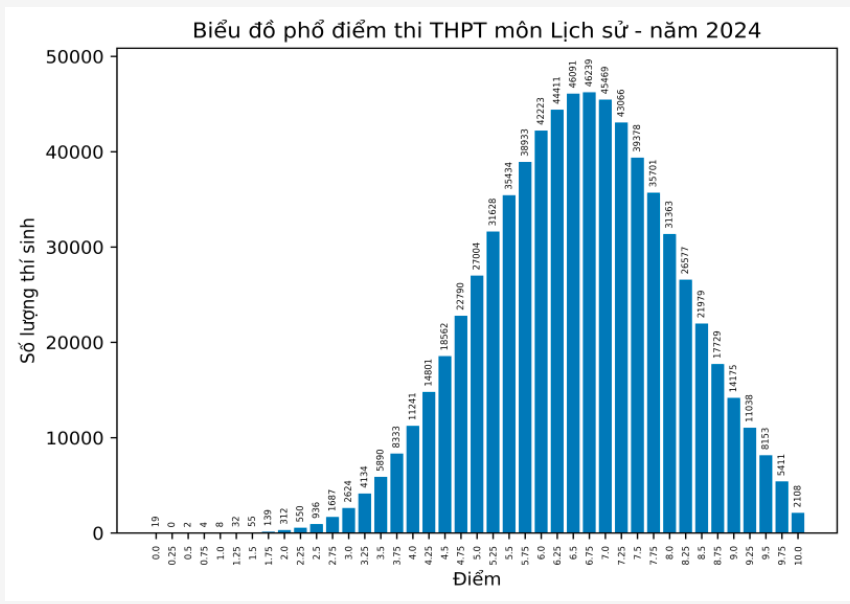
Geography: Although the average score decreased from 7.19 to 6.63, the number of 10 points doubled (from 3.175 to 6.907). The median decreased slightly, the rate of ≥7 points to 45.3%, but the exam was somewhat "open", encouraging practical thinking. Geography is still the elective subject with the second highest number of candidates (40.9%), showing stable attraction.
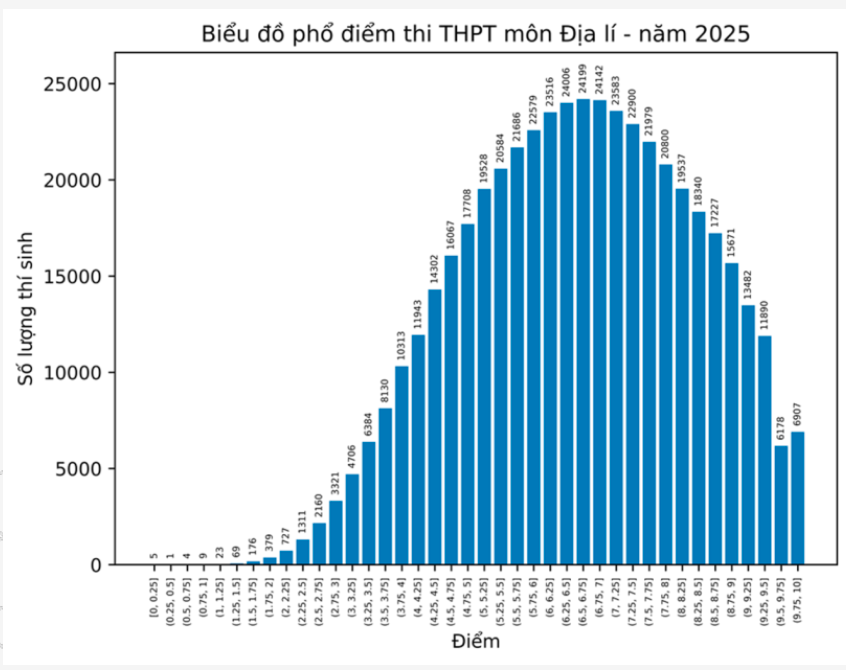
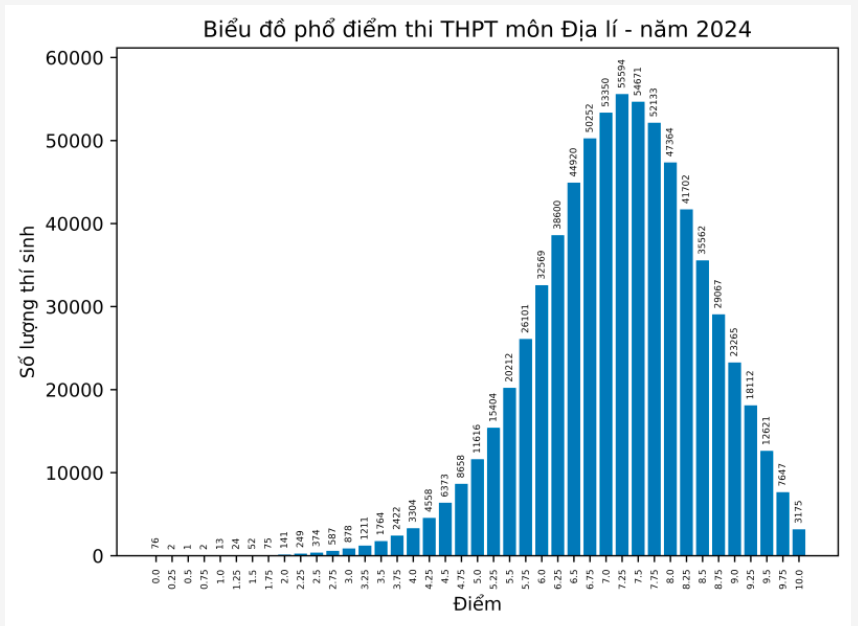
Economic and Legal Education: There is no longer a "rain" of high scores. The number of test takers has decreased sharply - to 21.15% compared to more than 50% in 2024. The average score has decreased from 8.16 to 7.69, but no candidates have failed. Although the percentage of candidates achieving ≥7 points is still high (78.1%), the score distribution shows that the test has been designed to differentiate better, effectively screening without causing pressure.
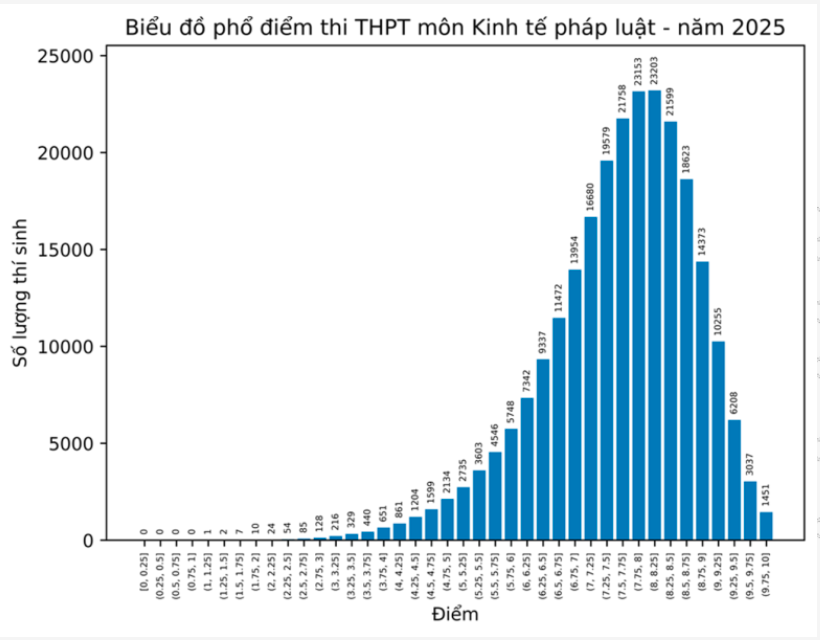
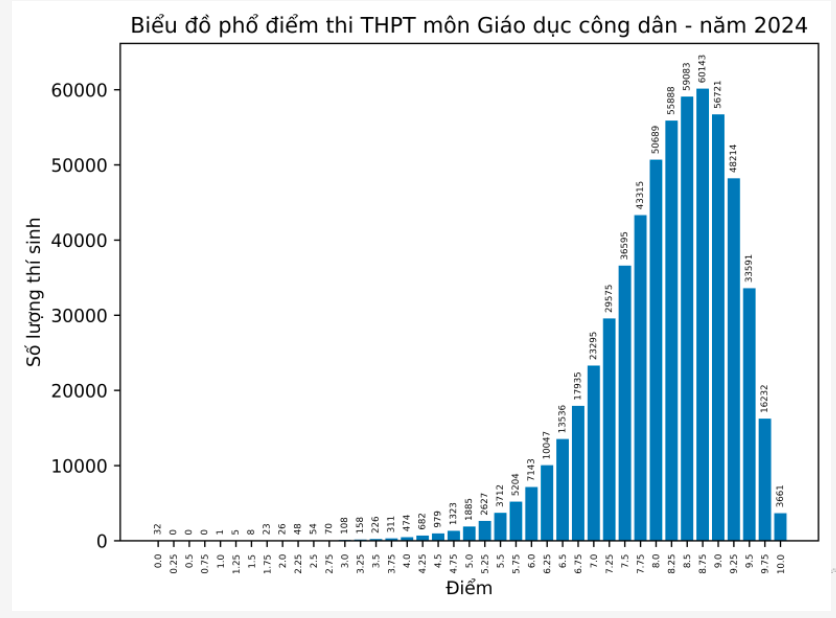
Score distribution of new subjects in the first graduation exam
The 2025 high school graduation exam will have three new subjects: Information Technology, Agricultural Technology and Industrial Technology. Although the number of candidates is still small, the initial signs are positive.
Informatics, 7,602 candidates (0.65%) took the exam, with an average score of 6.78 and a median of 6.75. The score distribution was good: 47.6% scored 7 or higher, only 11.2% scored below 5, and there were no failing scores. 60 candidates scored 10, showing that the exam was reasonable and within their ability, opening up development prospects for the subject.
Agricultural technology had the highest average score (7.72), median 7.75, low standard deviation (1.17), with 78.4% scoring 7 points or more, only 2.15% below 5 and no failing score. There were 101 candidates scoring 10 points. However, the number of candidates was still small (1.89%), which needs to be enhanced in school orientation.
The Industrial Technology subject has a lower score range: Average score 5.79, median 5.6, only 25.6% scored 7 or higher and 34% scored below 5. Although there were no failing scores, only 4 students scored 10. The high standard deviation (1.54) reflects a large differentiation, showing the need to improve the quality of teaching and learning and provide clearer orientation to develop human resources for the industrial sector.

Good differentiation exam, good students have the opportunity to shine
The 2025 high school graduation exam marks an important shift from knowledge assessment to capacity assessment, clearly demonstrated through the score distribution of subjects.
Math is a prominent example: Although the average score dropped sharply, 513 candidates scored 10, showing that the exam differentiated well, helping good students demonstrate their abilities. Literature, although the average score dropped slightly, the score range was stable, with many students scoring 9.25 - 9.75 points. The exam was innovative, using materials outside of the textbook, requiring rigorous thinking and reasoning.
The first IT exam held had a positive start: Average score 6.78; nearly 48% scored 7 points or more; no failing score; 60 candidates scored 10 points. The exam was assessed as being within the ability level, having classification, not challenging.
Some other subjects such as Physics (average score increased, 10 points increased 71 times), Agricultural Technology (average 7.72; nearly 80% achieved 7 or higher), Geography (10 points doubled)... show that the exam questions are scientifically constructed, close to capacity and support innovation in teaching and learning.
The 2025 exam will be more difficult and more differentiated to meet the dual goals: graduation and university admission. Although the average score of many subjects has decreased, the number of 10 points has increased from 10,878 (in 2024) to 15,331 (in 2025). The exam structure is reasonable: the basic part is for average students, the advanced part is for classification. Thanks to that, the exam is both popular and discovers excellent students. Nationwide, 9 candidates achieved a perfect score of 30/30 in the groups and 2 valedictorians had a total score of 39/40 points in 4 subjects, thereby affirming the spirit of self-study and orientation for human development.

High level of difficulty causes pressure, many subjects gradually lose their appeal
Despite many positive changes, the 2025 exam still revealed limitations. First of all, the difficulty level increased rapidly, causing many students to "run out of breath". In Math, up to 56.4% of candidates scored below average - that is, more than 650,000 students. In particular, the number of candidates with a score of ≤1 increased dramatically from 76 to 777. Biology had up to 32.4% of exams scored below 5 points, a sharp increase compared to 13.4% in 2024; Chemistry saw the rate of below average scores nearly double, from 15.8% to 30%.
Although English is no longer compulsory and only 30% of students take the exam, the average score has decreased slightly, the percentage of 7 and above has dropped sharply (25.2% to 15.1%) and the number of 10 points is only 141 - 1/4 of the previous year. This shows that the exam is not easy, even though the candidates have been "selectively selected".
More worryingly, many subjects are gradually losing their appeal: The number of candidates taking Chemistry has decreased from 32.47% to 20.61%; Biology has decreased nearly 5 times, from 342,000 to 70,000; Industrial Technology has only 2,290 candidates, accounting for 0.2% of the country. These subjects all have low scores, not creating trust with learners. Even Geography, which is part of the social group, has seen a sharp decrease in average scores, with the rate of scores below 5 points increasing from 4.37% to 18.69%, showing that social subjects are also more difficult.
Main causes of changes in score distribution
Firstly, the 2025 high school graduation exam will change direction according to the 2018 General Education Program, which was first applied to grade 12, although it is still in the area of overlap with the old program. Many subjects have clearly shown a new approach: Increasing practical questions, focusing on application skills, reducing memorization. This change creates a significant difference in score distribution, especially in Math and English.
Second, the score distribution is affected by the candidates. The fact that foreign languages are no longer compulsory means that only good students choose to take the exam, leading to a better score distribution, no longer having two peaks. In addition, some candidates "misunderstand" their abilities when choosing subjects, while schools and teachers have not provided effective advice to orient their abilities properly.
Third, the exam strategy has been adjusted. History in 2025 will be easier as a “testing ground” step when this subject becomes compulsory. Although it helps to raise scores, this reduces the ability to classify candidates. It is necessary to return to the path of improving the quality of the subject soon.
Fourth, the time to study the new program is short. Students only study the 2018 General Education Program for 3 years (grades 10-12), while many exam subjects still inherit the old structure, making it difficult for teachers and students to determine the focus of review, affecting the score distribution.
Solutions for the 2026 exam and subsequent years
Firstly, it is necessary to soon announce the orientation of the exam questions according to the 2018 General Education Program. To avoid information interference, the Ministry of Education and Training should issue a specific competency framework for each subject and announce illustrative questions that closely follow the orientation of competency assessment, helping teachers and students have appropriate teaching and learning plans from the beginning of the year.
Second, it is necessary to ensure differentiation without causing shock. As the Math subject in 2025 shows, increasing the difficulty level needs to be accompanied by clear differentiation, with a roadmap, while retaining "easy" content so that average and weak students can still achieve graduation scores.
Third, it is necessary to review the exam questions of the subjects of Economics and Law Education and History. It is necessary to add situational questions and require analysis and evaluation to limit rote learning and cramming.
Fourth, foreign language exams should be reformed to integrate four skills: Listening, speaking, reading, and writing instead of just testing reading and grammar. It is possible to organize two rounds of exams as some localities have proposed, or use standardized certificates if there is a strict accreditation system.
Fifth, it is necessary to build a smart score spectrum analysis system. Although the Ministry of Education and Training has announced score spectrums and statistical indicators, it is still necessary to invest in an academic data system to analyze more deeply by region, gender, school type, etc., thereby supporting fair and accurate policies.
Sixth, it is necessary to diversify the forms of student assessment. The graduation exam is only one part. It is necessary to expand large-scale assessments such as internal PISA, periodic surveys (5 years, 3 years), combining digital transcripts, interviews, learning products, etc. to build a comprehensive and humane assessment system.
The 2025 exam has opened the door to real learning and real testing. But for that door to truly open, timely adjustments and continuous support from policy to school are needed.
At the conference to inform about the score distribution of the 2025 High School Graduation Exam, Prof. Dr. Nguyen Dinh Duc - former Chairman of the Council of the University of Technology, Hanoi National University, commented that this year's score distribution reflects the quality and has good differentiation, especially in the two subjects of Math and English. Math has a high classification, the exam is considered the best from 2018 to present, helping to clearly identify good, excellent and average students. English also has a bright score distribution, the exam has adjusted the output standard from A2 to B1, meeting the requirements of international integration.
Source: https://giaoducthoidai.vn/ky-thi-tot-nghiep-thpt-2025-dau-an-cua-chuong-trinh-moi-post744349.html























![[Infographic] Schedule of the National High School Excellent Student Exam in 2025](https://vphoto.vietnam.vn/thumb/402x226/vietnam/resource/IMAGE/2025/11/18/1763438886912_training-strategy-2022-2874-5783-jpg.webp)


















![[Photo] General Secretary To Lam and National Assembly Chairman Tran Thanh Man attend the 80th Anniversary of the Traditional Day of the Vietnamese Inspection Sector](https://vphoto.vietnam.vn/thumb/1200x675/vietnam/resource/IMAGE/2025/11/17/1763356362984_a2-bnd-7940-3561-jpg.webp)







































































Comment (0)